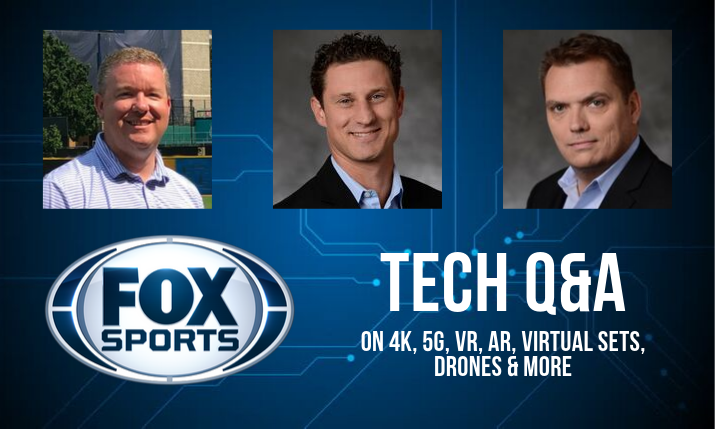Fox Sports Tech Q&A: Production Execs Talk 4K, 5G, VR, AR, Virtual Sets and Drones
Fox Sports' Michael Davies, Zac Fields, and Brad Cheney on what's now and what's next in sports TV
Story Highlights
FOX Sports continues to set a high bar in introducing and implementing next-generation tools and technology into its coverage of live sports. Beginning Thursday, Fox Sports will also be distributing this season’s Thursday Night Football NFL package in 4K UHD and HDR. With the NFL season heating up and MLB Postseason on the horizon, Fox Sports production executives Michael Davies, SVP Field and Technical Operations; Zac Fields, SVP Graphic Tech and Integration; and Brad Cheney, VP Field Operations and Engineering, touch on some of the hot technology topics, talking about what’s now and what’s next in the world of sports television.
The buzz around Virtual Reality (VR) in the sports television world appears to have calmed a little. Where are we in the evolution of VR as a component of sports television and what would it take to re-ignite the energy surrounding the technology just a year or so ago?
Davies: That VR has calmed down is a bit of an understatement. We really enjoyed working in VR and examining different ways we can produce experiences for our fans. Fundamentally, there are issues with Virtual Reality that are somewhat counter to what we believe in broadcasting sports – primarily the tribal nature of sports is somewhat mitigated by being in a first-person device. The other thing was (and is still) that consumer electronics are still not where consumers were expecting them to be – mobile devices were not up to par and quality devices required tethering. How can we re-ignite it? This will happen organically. One of the things of which we were most proud was that I thought we got to produce some quality VR programming and that kind of knowledge will be helpful if and when it comes back.
On the horizon, there is always AR in any one of its manifestations – head-mounted displays are coming out, but they are expensive and cumbersome. Also, 5G will bring fast and robust connectivity to interactive devices like this.
FOX Sports continues to roll out more and more 4K offerings, especially around big events. Why now and what’s next?
Davies: Ultra High Definition (UHD) has been feathered in on live events for the past two years, as there has been an inflection point with the types of televisions being sold, where it is virtually impossible to buy a set now that ISN’T high definition. Broadcast equipment is being sold in the same way – most equipment bought these days can do any flavor of UHD. Also, most of this technology can do roughly what its HD counterparts can deliver without a big jump in cost.
What seems to be making the difference now are the distribution methods to actually deliver UHD to the home, through our MVPDs, as well as through connected devices like Apple TV and Roku.
Finally, FOX Sports is concentrating on High Dynamic Range (HDR) more than we are the actual pixels. Even at 1080p (which upconverts nicely to 4K), an HDR picture not only looks great natively, but also can improve the broadcast quality of the Standard Dynamic Range (SDR) picture that most of the audience is still receiving.
Much is being made of 5G and all it offers in the world of television production. How will it impact FOX Sports and sports fans in general in the near and long-term future?
Davies: 5G seems to be the technology that promises to offer a lot to every industry, and sports production is no exception.
On the production side, 5G should offer methods of connectivity which will ease the burdens of connectivity and make fast, wireless and reliable data transfer even more quick and reliable. This will help the production process, as we port over devices like bonded cellular to 5G, enhancing the utility of these transmission schemes.
On the consumer side, the sky is the limit once you put +1 gig data transfer in the hands of fans. Everything from wireless 4K/HDR, wireless delivery, ultra-low latency data (think, sports betting), and AR and VR become much more powerful and useful with 5G as it rolls out.
FOX Sports unveiled its “virtual set” earlier this year in Charlotte, using a gaming engine from Epic Games and a great deal of studio/control room customization. What have you learned in the first six months of the NASCAR season, where does the studio have room to evolve and is FOX Sports looking at this technology for other sports properties moving forward?
Fields: It’s been a great deal of learning over the last couple years to get to our current position with the virtual set. We knew it was a large undertaking but perhaps underestimated a little bit just how involved every group needed to be. From artists, engineers, software programmers, production, and so on, it’s been a complete team effort. Without that buy-in, getting to where we are now would have been difficult. It has also been a great testing ground for us. We’ve made a conscious effort to continue to improve over time. Throughout the entire year, we’ve been slowly introducing new enhancements. This will continue since there really is no “can’t” with this technology. It’s just a matter of resources and time.
I think over the next five years you’ll see this technology be used more and more across FOX Sports properties. It’s such a great tool for our production teams to really enhance their storytelling.
Augmented Reality (AR) appears to be evolving quickly and proving useful both as an additive production element, as well as an ad sales opportunity. What’s next in the world of AR as it applies to sports television?
Fields: There are a couple things that will help take AR to the next level. First is the camera tracking. Systems are getting better at tracking and easier to use all the time. This is usually the hardest part about producing AR as it can be cumbersome and costly. The second area of growth is with OTT and ATSC 3.0. To enable viewers in the future to have customization could be a game changer.
FOX Sports started testing the use of aerial production drones more than four years ago and has actively used them as part of your NASCAR and USGA events, including the incorporation of an untethered drone at this year’s Daytona 500. With ever-increasing reliability, battery life and size efficiencies, are drones ready for use across any other FOX Sports properties?
Cheney: We are continually looking for and advocating the use of drones across all of our properties. Each year, we’ve seen exponential growth of their capabilities technologically, along with the steady openness of regulations for their safe use. This has allowed us to bring new insights to the sports we cover each year including having three stratospheres of aerial coverage at the 2019 U.S. Open at Pebble Beach with a live drone from the water and up to 80 feet, a crane camera at 125 feet and an aerial at 1,000 feet. This integration would not have been possible had we not started using drones back in 2015 as part of FOX Sports golf coverage and expanded it to racing, which allowed us to develop a new way to present coverage to our viewers. Every six months, there are radical improvements in technology, which allow us to be safer, closer and more mobile than ever before.
With FOX Sports having the upcoming World Series and Super Bowl, is there any new camera/audio technology your team is exploring?
Cheney: We are continuing our push this year to expand the use of 1080p and HDR across our most important programming including, Thursday Night Football and the American League Championship Series. The image quality is outstanding and High Dynamic Range brings a marked improvement, not only to those with the ability to watch it, but to everyone. The goal at FOX has always been to give you the best seat at the event, and audio is a key factor in accomplishing that. We continue to progress with new microphone technologies, allowing us better capabilities to better connect audio to exactly what you’re seeing throughout the events on all our networks. From mics buried in the playing surface to new specialty long-capture microphones, it’s going to sound more real than ever before.
This interview was conducted by Fox Sports and provided to SVG.




